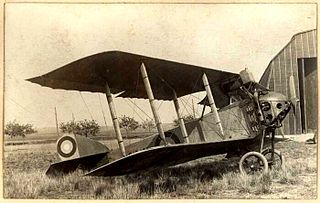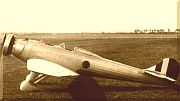
The Mikoyan-Gurevich MiG-8 Utka was a Soviet experimental aircraft. Built of wood, the aircraft was designed and built in 1945 to test the novel canard configuration. It also used a tricycle undercarriage, the first used by the OKB. It was modified to test a variety of vertical stabilizer and wingtip configurations and was later used as a liaison aircraft for many years by the design bureau.

The Yakovlev UT-1 was a single-seater trainer aircraft used by the Soviet Air Force from 1937 until the late 1940s.

The Shvetsov M-11 is a five-cylinder air-cooled radial aircraft engine produced in the Soviet Union between 1923 and 1952.

The Anatra DS or Anasal was a two-seat reconnaissance aircraft developed from the Anatra D (Anade). It was built in the Anatra factory in Odessa in the Russian Empire and flown during World War I by both sides during the Russian Civil War.
The Yakovlev Yak-5 was an experimental trainer aircraft designed by Yakovlev OKB in the Soviet Union, and first flown in 1944.

The Fiat G.5 was an Italian two-seat aerobatic tourer or trainer designed and built by Fiat Aviazione in small numbers.

The Tupolev I-14 was a Soviet fighter aircraft of the 1930s. It was a single-engined, single-seat monoplane with retractable undercarriage, designed to carry heavy armament, and as such was one of the most advanced fighters of its time. It was ordered into production, but this was cancelled after only a small number had been built, the competing Polikarpov I-16 being preferred.
The Gribovsky G-20 was an aerobatic trainer, designed in the USSR in the mid-1930s. Only one was built; re-engined in 1937, it was used to train many aerobatic pilots.

The Gribovsky G-8 was a single seat sports and training aircraft designed and built in the USSR in the early 1930s.
The Gribovsky G-10 was a single seat sports aircraft designed and built in the USSR in the early 1930s.
The Gribovsky G-15 was a single engine, side-by-side two seat touring aircraft built in USSR in the 1930s. Only one was completed.
The Gribovsky G-21 was a single engine cabin monoplane designed and built in the USSR in the mid-1930s. Intended for touring and civil utility rôles, only one was completed.
The Gribovsky G-25 was a Russian tandem seat biplane basic trainer built in the late 1930s. It was hoped to minimize unit costs by using a modified automobile engine but the G-25 did not reach production.
The Gribovsky G-26 was a single seat sports aircraft designed for high performance in the USSR in the later 1930s. Only one was built.
The Gribovsky G-27 was a light, economical, twin engined, multi-role aircraft built in the USSR in 1938-9. It did not reach production.
The Gribovsky G-28 was an advanced trainer for trainee fighter pilots, built in the USSR just before the German invasion in 1941. It satisfied VVS testing but changing priorities led to the abandonment of production plans.
The Gribovsky G-5 was a small, low powered Russian single seat sports aircraft from the late 1920s.
The Kalinin K-9 was a liaison/sport aircraft designed by Konstantin Alekseevič Kalinin. It had a parasol wing, only one was built in 1932. The prototype was evaluated during some test flights, but development was never carried out. The tests revealed that the K-9 was too large and too heavy in relation to the installed engine,.
The Grigorovich M-23bis was a Soviet biplane flying boat built during the 1920s.















